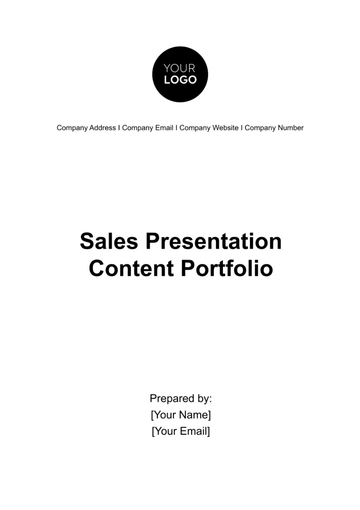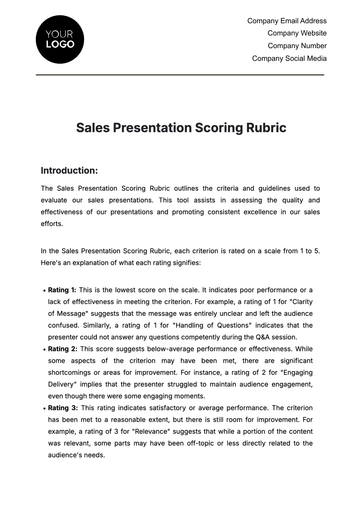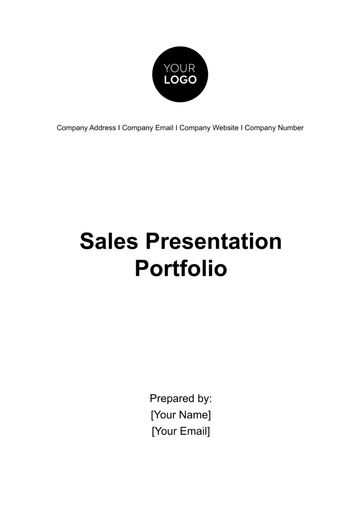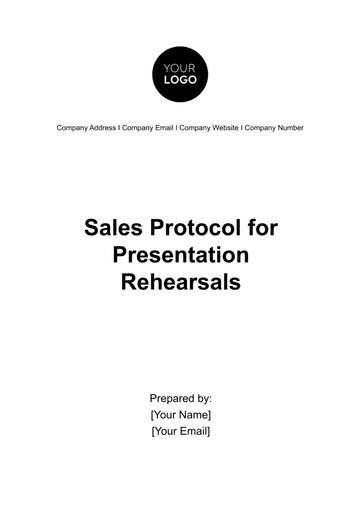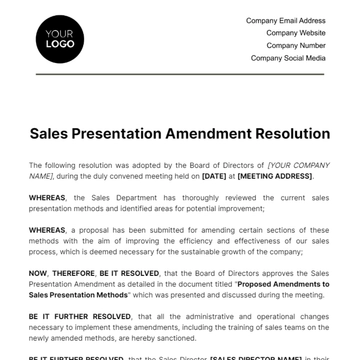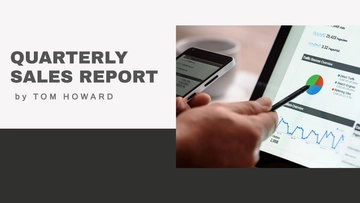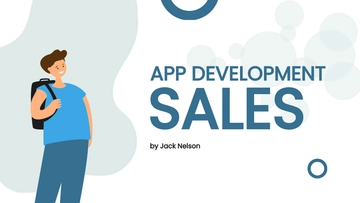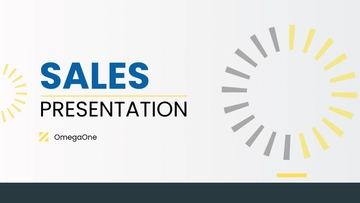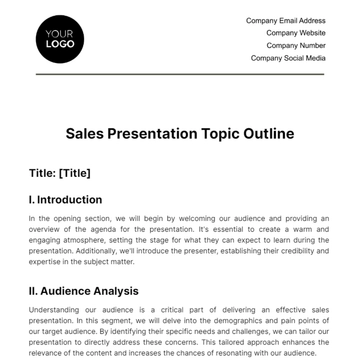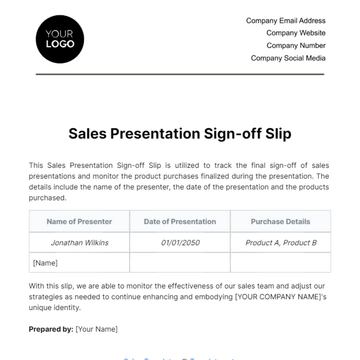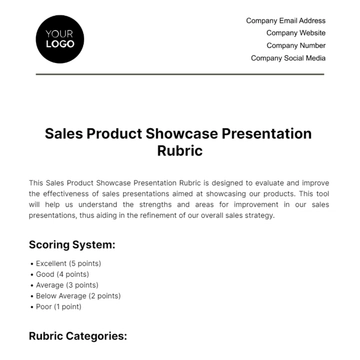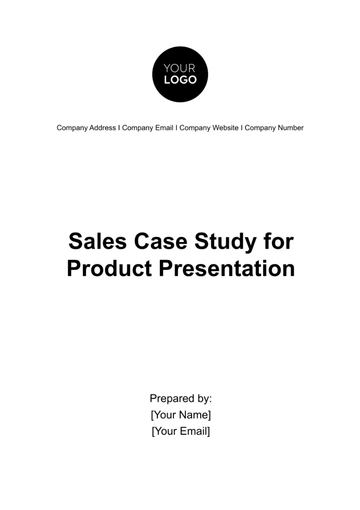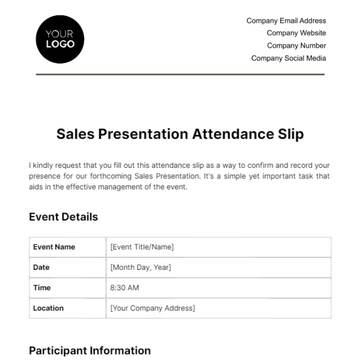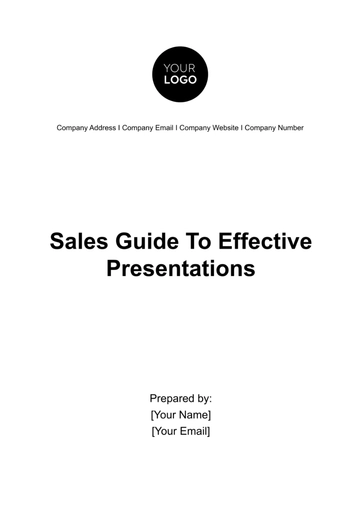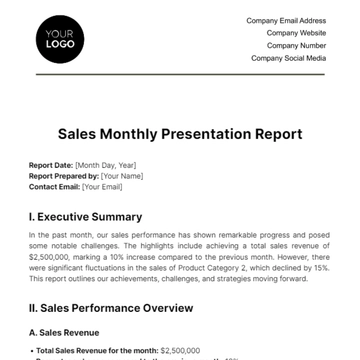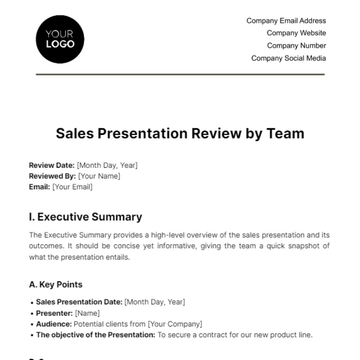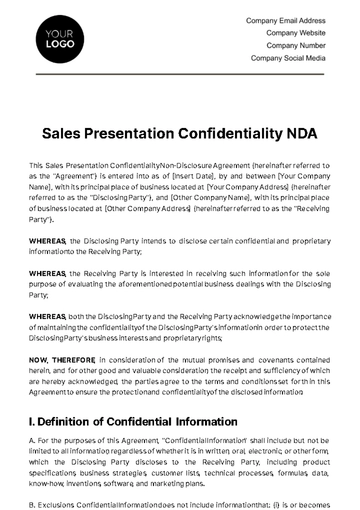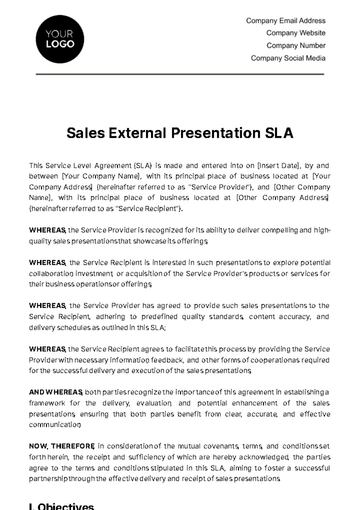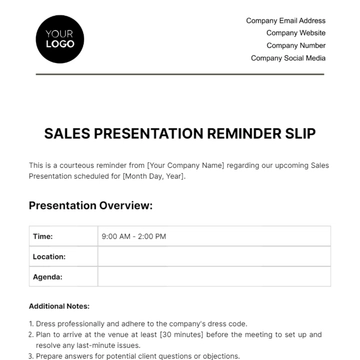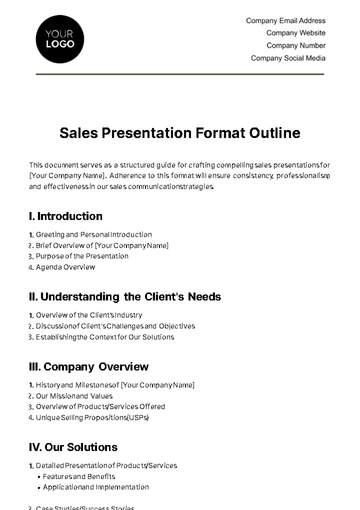Free Sales Collateral & Presentation Coordination Document
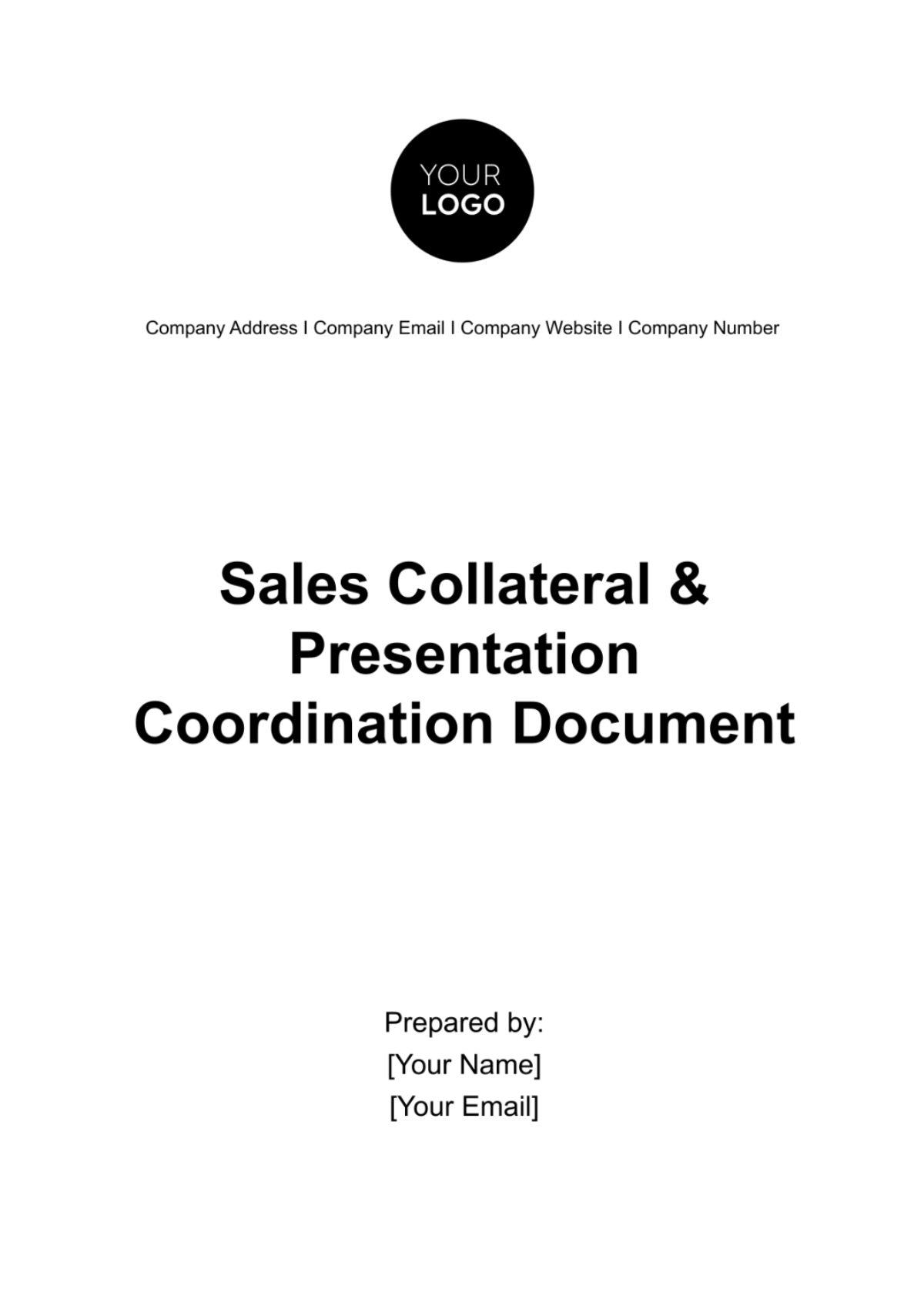
I. Introduction
A. Purpose
This coordination document serves as the cornerstone of our sales strategy for the launch of the "[Product Name]" Its primary purpose is to empower our sales team with the necessary resources and guidance to effectively promote and sell this groundbreaking energy-saving device. By ensuring that our team is well-equipped, we aim to maximize revenue generation and establish the [Product Name] as a leading solution in the energy conservation market.
B. Scope
The scope of this coordination effort covers the entire lifecycle of the [Product Name] sales campaign, from its initial launch to ongoing promotional activities. It includes the development and management of all sales collateral materials and the coordination of presentations for our sales team to engage with customers and strategic partners. This effort spans multiple channels, including online and offline, ensuring that our messaging is consistent and compelling across all touchpoints.
C. Background
Our target audience includes homeowners, small business owners, and facility managers seeking sustainable and cost-effective energy solutions. Our sales strategy emphasizes personalized demonstrations and persuasive collateral to showcase the [Product Name]'s capabilities.
II. Collateral Content
Product Description
The [Product Name] is a remarkable energy-saving device designed to revolutionize how we manage electricity consumption. It offers an array of key features and benefits that make it a standout solution in the energy conservation market.
Real-Time Energy Monitoring: Users can monitor their energy consumption in real-time through a user-friendly interface, gaining insights into usage patterns and opportunities for optimization.
Automatic Load Optimization: The device employs sophisticated algorithms to balance and optimize electrical loads, ensuring that energy is used efficiently without compromising on comfort or productivity.
Seamless Smart Home Integration: It seamlessly integrates with existing smart home systems, allowing users to control and manage their energy consumption remotely via mobile apps or voice commands.
Quick and Easy Installation: Installation is hassle-free and can be completed in a matter of minutes. No specialized technical knowledge is required.
Technical Specifications
The [Product Name] boasts impressive technical specifications, ensuring that it meets the highest standards of performance and safety.
Dimensions: Compact and space-efficient, with dimensions of 6.5" x 4.5" x 2".
Construction: It is built using high-impact, fire-resistant ABS plastic, guaranteeing durability and safety.
Compatibility: Designed to work seamlessly with the majority of residential and commercial electrical systems, making it a versatile solution for various applications.
Certifications: The device holds UL Listing for safety, providing peace of mind to users, and is ENERGY STAR® certified for its exceptional energy efficiency.
These technical specifications underline the [Product Name]'s exceptional quality and reliability, assuring customers that they are investing in a top-tier energy-saving solution.
III. Presentation Coordination
A. Presentation Outline
A well-structured presentation is crucial to effectively communicate the value of the [Product Name] to potential customers. Here's an outline of the presentation:
Introduction: Begin with a captivating introduction that grabs the audience's attention. Highlight the importance of energy conservation in today's world and introduce the [Product Name] as the solution.
Product Overview: Provide an in-depth overview of the [Product Name]. Emphasize its key features, benefits, and how it works. Use visuals, such as product images and infographics, to make the information more engaging.
Customer Success Stories: Share real-world examples of customers who have benefited from the [Product Name]. Use case studies, before-and-after scenarios, and testimonials to showcase its effectiveness.
Technical Details: Dive into the technical aspects of the device. Explain its functionality, including real-time energy monitoring and load optimization. Use charts and graphs to illustrate data trends and efficiency gains.
Pricing and Packages: Discuss pricing options and packages available to customers. Show how the [Product Name] offers excellent value for money and potential return on investment.
Installation and Support: Explain the ease of installation and the after-sales support provided. Address any potential concerns the audience may have regarding installation or maintenance.
Q&A Session: Allocate time for questions and answers to address any queries or doubts the audience may have.
B. Slide Content
Each slide of the presentation should contain concise yet compelling content that aligns with the outline. For example, the "Product Overview" slide can include bullet points highlighting key features, while the "Customer Success Stories" slide can feature quotes from satisfied customers.
C. Speaker Notes
Incorporate detailed speaker notes for each slide to guide the presenter. For instance, in the "Technical Details" section, speaker notes can provide explanations of complex technical concepts in a simplified manner, ensuring the presenter effectively conveys the information.
D. Visual Elements
Visual elements play a crucial role in keeping the audience engaged. Consider using high-quality images of the [Product Name], infographics to illustrate its benefits, and charts to showcase energy savings data.
E. Rehearsal Schedule
A well-rehearsed presentation is essential for a confident and successful delivery. Establish a rehearsal schedule that includes multiple practice sessions. Start rehearsals well in advance of the actual presentation date to allow for adjustments and improvements.
IV. Delivery
A. Distribution Channels
To ensure that the presentation reaches its intended audience, we will utilize multiple distribution channels. These include:
Sales Team: The sales team will be equipped with the presentation to use in face-to-face meetings with potential customers.
Online Platforms: The presentation will be made available on our company website and social media channels, allowing prospects to access it conveniently.
Email Campaigns: We will include the presentation in email campaigns targeting leads and existing customers.
Webinars and Seminars: For larger audiences, we will conduct webinars and seminars, using the presentation as a central component.
B. Sales Team Training
To guarantee that our sales team delivers the presentation effectively, we will provide comprehensive training. Training will cover the following areas:
Product Knowledge: Ensuring that our sales team fully understands the [Product Name]'s features, benefits, and technical details.
Presentation Skills: Equipping our team with effective presentation techniques to engage and persuade the audience.
Handling Questions: Preparing our sales team to address common questions and objections.
Using Visuals: Instructing them on how to effectively use visuals and speaker notes during the presentation.
C. Timeline
A well-defined timeline is essential for a successful sales campaign. The timeline includes the following milestones:
Content Creation: Specify deadlines for creating presentation content, including visuals and speaker notes.
Rehearsals: Allocate time for multiple rehearsal sessions to ensure the team is well-prepared.
Distribution: Plan when and how the presentation will be distributed through various channels.
Training: Outline the training schedule to ensure our sales team is ready for presentations.
V. Measurement and Evaluation
A. Key Performance Indicators (KPIs)
To gauge the effectiveness of our sales collateral and presentations, it's essential to establish Key Performance Indicators (KPIs). These metrics will help us track the success of our efforts and make data-driven improvements as needed.
Conversion Rate: The percentage of leads that convert into customers after a presentation.
Engagement Rate: Measuring audience engagement during presentations, such as questions asked or interactions during webinars.
Content Effectiveness: Evaluating the impact of individual pieces of collateral content based on customer feedback and usage statistics.
Sales Revenue: Tracking the revenue generated directly attributable to our sales collateral and presentations.
B. Evaluation Process
We will conduct regular evaluations to ensure that our sales collateral and presentations align with our goals and meet the needs of our target audience. The evaluation process will include:
Feedback Collection: Gathering feedback from the sales team regarding the effectiveness of collateral and presentations in real-world sales interactions.
Customer Surveys: Seeking input from customers who have viewed our collateral or attended presentations to assess their satisfaction and any areas for improvement.
Data Analysis: Analyzing data related to KPIs and adjusting our strategy accordingly.
Content Updates: Making necessary updates and improvements to collateral and presentations based on evaluation findings.
VI. Continuous Improvement
A. Optimization Strategy
Continuous improvement is integral to our sales strategy. We will develop an optimization strategy to refine our collateral and presentations over time, ensuring they remain relevant and compelling.
Content Refresh: Regularly updating content to reflect the latest product features, industry trends, and customer feedback.
A/B Testing: Experimenting with different collateral and presentation variations to identify what resonates best with our audience.
Training and Skill Enhancement: Offering ongoing training to our sales team to keep them updated on product knowledge and presentation skills.
Technology Integration: Exploring new technologies or tools that can enhance our collateral and presentation capabilities.
B. Review and Feedback Loops
To facilitate continuous improvement, we will establish review and feedback loops. These loops will involve regular meetings and communication channels where the sales team can provide input, share observations from customer interactions, and suggest improvements to collateral and presentations.
VII. Appendices
A. Glossary
A glossary is a valuable resource for both our sales team and customers. It defines key terms and acronyms related to the [Product Name], ensuring that everyone involved in the sales process understands the terminology used.
Energy Consumption: The amount of electrical energy used by a device or system, typically measured in kilowatt-hours (kWh).
Load Balancing: The process of optimizing the distribution of electrical loads to ensure efficient energy usage and prevent overloading.
ENERGY STAR®: A widely recognized certification program that identifies energy-efficient products and practices.
UL Listing: A certification provided by Underwriters Laboratories (UL) indicating that a product meets specific safety and performance standards.
Smart Home Integration: The capability of a device to connect and communicate with other smart home systems and devices for enhanced automation and control.
B. Supporting Documents
Supporting documents provide additional information and resources that complement the sales collateral and presentations. These documents can be used by the sales team for reference or shared with interested customers for in-depth insights.
Case Studies: Detailed case studies showcasing real customer success stories, including data on energy savings and testimonials.
Product Brochure: A visually appealing brochure summarizing key product features and benefits.
Technical White Paper: A comprehensive technical document providing an in-depth analysis of the [Product Name]'s technology and its impact on energy conservation.
FAQ Sheet: A document addressing frequently asked questions about the product, installation process, and maintenance.
VIII. Conclusion
In conclusion, this Sales Collateral & Presentation Coordination Document lays the foundation for a successful sales campaign for the [Product Name]. It provides a clear roadmap for creating persuasive sales collateral, coordinating impactful presentations, and effectively delivering our message to potential customers.
By adhering to the guidelines and utilizing the resources outlined in this document, we can empower our sales team to engage with confidence and enthusiasm. The [Product Name] is not just a product; it's a solution that offers tangible benefits to our customers and contributes to a sustainable future.
For any inquiries or clarifications regarding this document, please do not hesitate to contact:
[Representative Name]
[Representative Email]
[Date]
- 100% Customizable, free editor
- Access 1 Million+ Templates, photo’s & graphics
- Download or share as a template
- Click and replace photos, graphics, text, backgrounds
- Resize, crop, AI write & more
- Access advanced editor
Coordinate your sales collateral and presentations effortlessly with our Sales Collateral & Presentation Coordination Document Template from Template.net. This template helps streamline the creation, management, and distribution of sales materials and presentations, ensuring consistency and effectiveness in your sales efforts. Maximize your team's productivity and impact. Download now to elevate your sales collateral and presentations coordination in just a few clicks! Don't miss out on potential opportunities.
You may also like
- Aesthetic Presentation
- Presentation Background
- Slide Show Presentation
- Cute Presentation
- Education Presentation
- Border Frames Presentation
- Teacher Presentation
- Professional Presentation
- Timeline Presentation
- Brand Presentation
- Promotion Presentation
- Business Presentation
- Event Presentation
- Company Presentation
- Startup Presentation
- University Presentation
- Food Presentation
- Music Presentation
- School Presentation
- Art Presentation
- Marketing Presentation
- Business Plan Presentation
- Mobile Presentations
- Freelancer Presentation
- Project Presentation
- Agency Presentation
- Sales Presentation
- HR Presentation
- Product Presentation
- Roadmap Presentation
- Slideshow
- Technology Presentation
- Real Estate Presentation
- Medical Presentation
- Speaker Presentation
- Construction Presentation
- Conference Presentation
- Restaurant Presentation
- IT and Software Presentation
- Portfolio Presentation
- Campaign Presentation
- Game Presentation
- History Presentation
- Math Presentation
- Lesson Presentation
- Health Presentation
- Graduation Presentation
- New Year's Day Presentation
- Social Studies Presentation
- Photography Presentation
- Social Media Presentation
- Valentine's Day Presentation
- Services Presentation
- Workshop Presentation
- Organization Presentation

